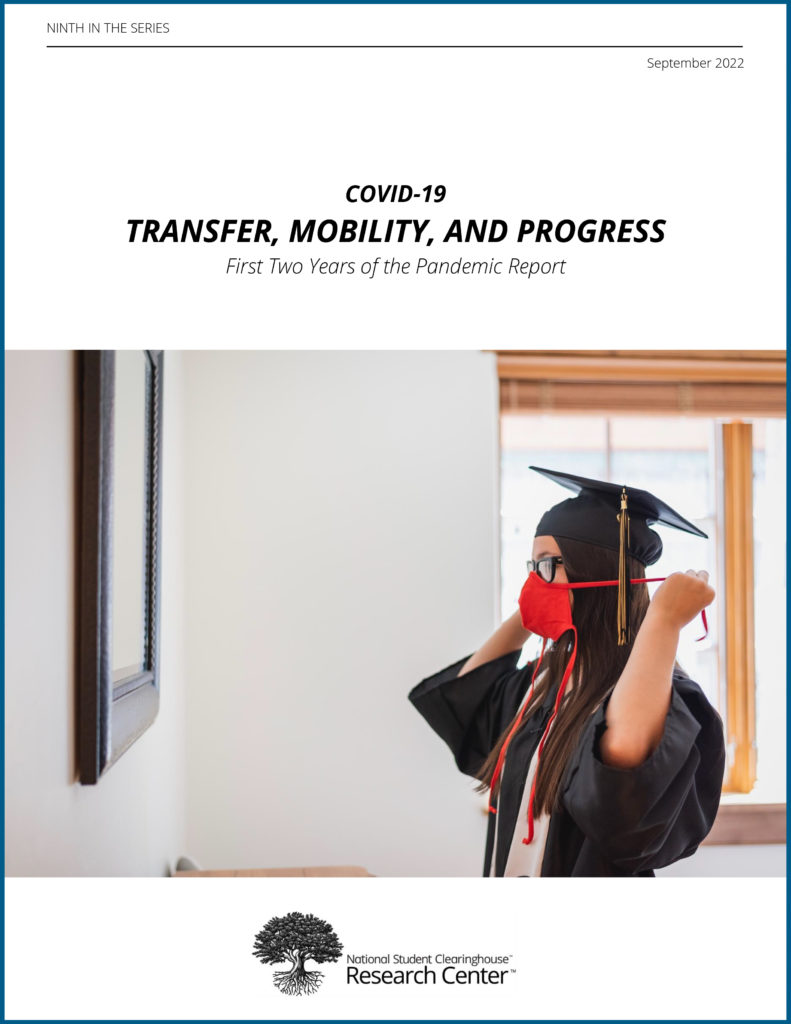The Covid pandemic significantly dampened transfers among all higher education institutions, but especially among public two-year college students, according to a new report from the National Student Clearinghouse (NSC) Research Center.
Upward transfer rates dropped -9.7% (about 86,000 students) over two years, with the bulk (-7.5%) coming in the second year of the pandemic, the report shows. Students at associate-degree-granting colleges who didn’t earn their two-year degree before transferring declined -9.3% (49,900 students) over the two years; among students who earned their degree prior to transferring, the decline — which occurred mostly in the second year — was -10.3% (36,100 students).
Lateral transfers among two-year colleges also saw larger declines, totaling -21.3% (113,300 students) during the two years. Reverse transfers, meanwhile, saw a decrease of -18% (or 66,900 students) over the two years.
Lateral transfers among four-year institutions saw a -7.6% drop over the two-year period, but those colleges saw a 0.3% increase in the second year, the report says.
Overall, higher education saw a two-year loss of 296,200 transfer students, or -13.5%, during the pandemic, the NSC Research Center notes.
Concerns over persistence after transferring
Doug Shapiro, executive director of the NSC Research Center, said during a media call on Monday that the overall declines are not surprising. He noted that declining enrollments did affect the number of transfers, but students who considered transferring also were likely impacted by concerns about their financial, family and academic situations resulting from the pandemic, as well as an improving job market. Several reporters asked if there could also be other reasons in the mix, such as difficulty in transferring due to issues at the institutions, dissatisfaction with online learning during Covid, and other factors. Shapiro said it’s possible, but the center didn’t research that.
“Transferring during a pandemic is hard, harder than just staying enrolled,” he said.
Shapiro noted that transferring students have to deal with all the shifting changes in policies resulting from the pandemic at two separate institutions — all that without the benefit of on-campus advisors and other campus-based support networks that students would normally have access to.
But the dropping persistence rates — the number of students who remained enrolled into the following term after transferring — are especially concerning, he said.
“You would think that those who had managed to transfer and in times like this would have to be among the most determined and persistent students around,” he said. “These results should be a wake-up call to colleges that transfer-in students really need services and support after transfer to help them stay on track.”
The NSC Research Center will host a webinar on Tuesday at 2 p.m. ET to discuss its findings on transfers. The panel discussion will include the center’s Doug Shapiro, John Fink of the Community College Research Center at Columbia University and others.
Shapiro said the downward trends among reverse and lateral transfers — which are basically all the transfers into two-year institutions — stood out to him. Historically, these pathways are important as “back-stops” for students at risk of dropping out, Shapiro said.
“The ability to adapt easily is increasingly critical in these turbulent times,” he said. “Students who feel trapped in programs that no longer meet their needs are more likely to stop out or drop out altogether.”
Shapiro said the lateral and reverse transfer declines are not just an issue for two-year colleges but for all of higher education.
“It’s not just a symptom of the declines that we’ve been seeing among community college students” that the center has tracked in its enrollment reports, he said. “By making it more difficult to transfer, the pandemic has likely inhibited student success among continuing students everywhere.”
Breaking down the data further
The NSC Research Center also examined transfers based on gender, age and race/ethnicity, and it provided data on transfers at rural colleges and universities, Hispanic-serving institutions, and historically Black colleges and universities.
The decline in upward transfers was greater among men over the two years (-11.7% compared to -8.5% for women), but the overwhelming majority of the decline for women occurred in the second year (-8.2%).
In upward transfer pathways, older students saw double-digit rate declines, the report says. However, younger students made gains in year 2 (1.4% or 3,700 students), which were enough to overcome decreases in year 1 (-0.4%, about 1,100 students) and actually surpass pre-pandemic levels, the report says.
Looking at students’ race and ethnicity, Black and white students saw the biggest drops in upward transfers, -13.9% and -13.6%, respectively, over the two-year period. Latinx and Asian students actually saw a bump up in upward transfers during the first year — 1.8% and 4.8%, respectively — before declining in the second year of the pandemic by -7.8% each.
Rural-serving institutions saw slightly steeper declines in upward public four-year transfers than non-RSI students over the two years, -9.5% compared to -9.1%.


